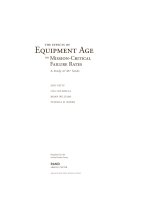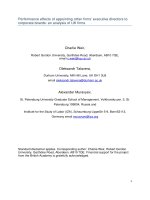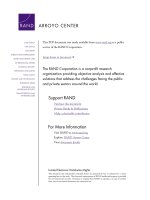Effects of different types of bleaching
Bạn đang xem bản rút gọn của tài liệu. Xem và tải ngay bản đầy đủ của tài liệu tại đây (699.54 KB, 43 trang )
School of Science and Engineering, Department of Textile Engineering
SOUTHEAST
UNIVERSITY
Eects of dierent types of bleaching
Name : MAZADUL HASAN SHESHIR
ID: 2010000400008
Batch: 13th Batch (Session 2009-2013)
Department: Wet Processing Technology
Email:
Blog: www. Tex6lelab.blogspot.com
Southeast University
Department of Tex6le Engineering
PREPARED BY
©right
School of Science and Engineering, Department of Textile Engineering
SOUTHEAST
UNIVERSITY
Prof . Engr. Dr. Ayub Nabi Khan Bleaching 3
Bleaching
The process of decolorize the natural coloring matter present in the cloth treating with some oxidizing agent and reducing agent and ensure the
permanent whiteness is called bleaching.
Objects
A high uniform absorbency of fabric to water and dye stuffs.
Uniform degree of whiteness.
Fabric should not damage and DP should remain high.
Destruction of natural coloring matters from the fabric.
To ensure a level dyeing properties.
To make the textile materials suitable for subsequent processing. (Dyeing, printing, etc.)
School of Science and Engineering, Department of Textile Engineering
SOUTHEAST
UNIVERSITY
Types of bleaching agents
Oxidative bleaching agent
Hydrogen peroxide bleaching.
Sodium chlorite bleaching.
Hypochlorite bleaching.
Percretic acid
Ozone
Bleaching powder
Reductive bleaching
Zn dust
Staneous chlorite
Ferous sulphate
Sulpher dioxide
Sodium hydrosulphate
Prof . Engr. Dr. Ayub Nabi Khan Bleaching 4
School of Science and Engineering, Department of Textile Engineering
SOUTHEAST
UNIVERSITY
Prof . Engr. Dr. Ayub Nabi Khan Bleaching 5
Reducing bleaching is a temporary bleaching process because after bleaching there is possibility that the oxygen in the air may reoxidize
and it will return to its original state. But oxidizing bleaching is permanent because it gives almost invariably a more permanent white.
Bleaching can be done in various process:
1. Hypochlorite bleaching for 100% cotton (less used)
2. Hydrogen peroxide bleaching for 100% cotton (more used)
3. Sodium Chlorite bleaching only used for special sector and only for polyester and cotton blend.
4. Peracetic acid bleaching can also be done for the better improvement of the process and this is not still used in our
country commercially.
School of Science and Engineering, Department of Textile Engineering
SOUTHEAST
UNIVERSITY
Hypochlorite bleaching
Prof . Engr. Dr. Ayub Nabi Khan Hypochlorite bleaching 6
School of Science and Engineering, Department of Textile Engineering
SOUTHEAST
UNIVERSITY
Prof . Engr. Dr. Ayub Nabi Khan Hypochlorite bleaching 7
In textile hypochlorite bleaching sodium hypochlorite [NaOCl] or calcium hypochlorite [Ca(OCl)2] may be used as
hypochlorite bleaching agent.
Differences between Ca(OCl)2 and NaOCl bleaching
Ca(OCl)
2
NaOCl
1.It is unstable 1.It is stable
2.It produces CaCO
3
precipitate 2. It doesn’t produce any precipitate
3.It makes harsh feeling on the fabric 3.It doesn’t make harsh feeling on
the fabric
4.Comperatively cheaper than
NaOCl bleaching
4.Higher cost than Ca(OCl)
2
bleaching
School of Science and Engineering, Department of Textile Engineering
SOUTHEAST
UNIVERSITY
Sequence of cotton bleaching
NaOCl Antichlore treatment Cold wash
Ca(OCl)2 souring Antichlore treantmnet Cold was
It is seen that souring is used only for Ca(OCl)2 but antichlore treatment is used for both. Cause when Ca(OCl)2 is used, it reacts with
atmospheric CO2 to give CaCO3 as white precipitate. CaCO3 deposited on the fabric causing harsh handling and uneven dyeing, hence
it has to separate and souring (acid treatment) is done to remove it.
Ca(OCl)2 + CO2 + HO2 CaCO3 + HOCl
Prof . Engr. Dr. Ayub Nabi Khan Hypochlorite bleaching 8
School of Science and Engineering, Department of Textile Engineering
SOUTHEAST
UNIVERSITY
Souring
The treatment by which the fabrics after processing with alkali (scouring/bleaching) are treated with HCl or dilute H2SO4 for removing
alkali or neutralization for alkali is called scouring. This process is necessary in case of Ca(OCl)2 bleaching.
CaCO3 + 2HCl = CaCl2 + CO2 + H2 O
CaCO3 + H2SO4 = CaSO4 + CO2 + H2 O
Antichlore treatment
In case of hypochlorite bleaching (OCl
-
) hypochlorous ion is produced, which will react with residual protein to form chloramines >
NCl which is corrosive and toxic. Cl2 is also produced which also unhygienic and irritate to skin. Moreover >NCl reacts with moisture
and gradually cotton becomes yellowish due to forming of HCl.
Prof . Engr. Dr. Ayub Nabi Khan Hypochlorite bleaching 9
School of Science and Engineering, Department of Textile Engineering
SOUTHEAST
UNIVERSITY
OCl
-
+ resedual protein >NaCl
>NaCl + H2 O HCl
Prof . Engr. Dr. Ayub Nabi Khan Hypochlorite bleaching 10
School of Science and Engineering, Department of Textile Engineering
SOUTHEAST
UNIVERSITY
Treatment procedure:
In an experiment the hypochlorite bleaching scoured fabric samples (10 g. each) were treated with sodium hypochlorite solutions (0.5,
1.0, 1.5 g/liter available chlorine) at different pH values (11, 12, and 13) for 15 min., keeping a liquor ratio of 30:1 at 30º, 45º, 60º C. the
bleached samples were washed, scoured with 0.1% hydrochloric acid and washed free from the acid.
For the other purpose of comparison two pieces of scoured cloth were bleached with sodium hypochlorite solution (3 g/liter available
chlorine) at pH 11 and 30ºC for 1 hr and scoured as above.
Prof . Engr. Dr. Ayub Nabi Khan Hypochlorite bleaching 11
School of Science and Engineering, Department of Textile Engineering
SOUTHEAST
UNIVERSITY
Result:
Prof . Engr. Dr. Ayub Nabi Khan Hypochlorite bleaching 12
Conc. Of NaOCl
g/liter avail. Cl
2
Temp. ºC Whiteness
pH 11
0.5 30 Yellowish white
0.5 45 Dull white
0.5 60 White
1.0 30 Yellowish white
1.0 45 White
1.0 60 White
1.5 45 White
1.5 30 Dull white
School of Science and Engineering, Department of Textile Engineering
SOUTHEAST
UNIVERSITY
Conc. Of NaOCl g/liter
avail. Cl
2
Temp. ºC Whiteness
pH 12
0.5 30 Good white
0.5 45 Slightly white
0.5 60 Dull white
1.0 30 Yellowish white
1.0 45 White
1.0 60 White
1.5 30 Yellowish white
1.5 45 Dull white
1.5 60 White
Prof . Engr. Dr. Ayub Nabi Khan Hypochlorite bleaching 13
School of Science and Engineering, Department of Textile Engineering
SOUTHEAST
UNIVERSITY
Conc. Of NaOCl g/liter
avail. Cl
2
Temp. ºC Whiteness
pH 13
0.5 30 Dull white
0.5 45 White
0.5 60 White
1.0 30 Dull white
1.0 45 Cream white
1.0 60 White
1.5 30 Slightly white
1.5 45 White
1.5 60 White
Prof . Engr. Dr. Ayub Nabi Khan Hypochlorite bleaching 14
School of Science and Engineering, Department of Textile Engineering
SOUTHEAST
UNIVERSITY
At a given hypochlorite concentration, the bleaching efficiency increases with an
increase in either the temperature or in the pH. Good white effects are obtained when
bleached for 15 min. at 60ºC with 1.5 g/liter available chlorine. In case of 1 hr process
with 3 g/liter available chlorine at 30ºCwhite effects are obtained.
Conc. Of NaOCl g/liter
avail. Cl
2
Temp. ºC Whiteness
pH 11
3.0 30 (1hr) White
3.0 30 (1hr) White
Prof . Engr. Dr. Ayub Nabi Khan Hypochlorite bleaching 15
School of Science and Engineering, Department of Textile Engineering
SOUTHEAST
UNIVERSITY
Advantages
–
Cheapest
–
Variety of machine can be used
–
Large batches fabric can be processed
–
Simple machine can be used
Disadvantages
–
There is a danger of damaging the fabric due to accidental lowering of pH.
–
The process is slow, it is carried out at low temperature and it is therefore
difficult to integrate into rapid continuous operation.
–
There is danger of yellowish upon storage.
–
The relatively high salt loads in the process are undesirable for ecological
reason
Prof . Engr. Dr. Ayub Nabi Khan Hypochlorite bleaching 16
School of Science and Engineering, Department of Textile Engineering
SOUTHEAST
UNIVERSITY
Hydrogen peroxide bleaching
Prof . Engr. Dr. Ayub Nabi Khan 17
School of Science and Engineering, Department of Textile Engineering
SOUTHEAST
UNIVERSITY
Hydrogen peroxide is called universal bleaching agent and most widely used for bleaching and over 90% of all fibre can be bleached
with H2O2. It can be used for vegetable fibre as well as protein fibre although the cost of H2O2 is greater then hypochlorite.
Properties of hydrogen peroxide:
(a)
H2O2 is a clear colorless liquid.
(b) Strength of H2O2 is 35% - 70%.
(c) Should store away from light.
(d) In presence of heavy metal like gold, silver, platinum it decomposes with the (e) liberation of oxygen.
(f) This material is irritant for skin
(g) This is non flammable.
Prof . Engr. Dr. Ayub Nabi Khan Hydrogen peroxide bleaching 18
School of Science and Engineering, Department of Textile Engineering
SOUTHEAST
UNIVERSITY
Bleaching methods with hydrogen peroxide:
There are two chief methods for bleaching of cotton goods with H2O2. They are:
(a) Bleaching in Kier (discontinuous).
(b) Bleaching in J-Box.
Treatment procedure:
In continuous bleaching the cloth was first desized with desizing agent (3 g/liter) at Ph 7 for 2 hrs at 70˚ - 75˚C. This was followed by
scouring by boiling in a stainless steel vessel with sodium hydroxide (3 g/liter), sodium carbonate 2(g/liter) and soap 2(g/liter) for 4 hrs.
The cloth was then mercerized under tension for 10 min. with sodium hydroxide solution (50˚ Tw) containing wetting agent (15 ml/liter).
It was washed , scoured with oxalic acid (10 g/liter) solution.
the liquor ratio was 20:1.
Prof . Engr. Dr. Ayub Nabi Khan Hydrogen peroxide bleaching 19
School of Science and Engineering, Department of Textile Engineering
SOUTHEAST
UNIVERSITY
Temperature
ºC
Time, hr. Sodium
silicate, g
100ºTw
solution/liter
Peroxide
decomposition
%
Reflectance
95
2 5 36.0 84
2 40 95.0 88
½ 5 - -
½ 40 - -
80
2 10 32.5 85.0
10 0 66.0 72
60
2 40 67.0 86.5
10 5 - 78.5
Prof . Engr. Dr. Ayub Nabi Khan Hydrogen peroxide bleaching 20
School of Science and Engineering, Department of Textile Engineering
SOUTHEAST
UNIVERSITY
It is seen that bleaching at 95˚ C for 2 hrs with 40 G/liter Tw solution of sodium silicate gave the best
result with the reflectance of 88.0, but 95% peroxide has been decomposed. With the increase in time
and temperature improved the bleaching rate but a marked decrease in peroxide decomposition has
been observed.
Prof . Engr. Dr. Ayub Nabi Khan Hydrogen peroxide bleaching 21
School of Science and Engineering, Department of Textile Engineering
SOUTHEAST
UNIVERSITY
Advantages
–
H
2
O
2
doesn’t react with residual protein of fiber and no need of antichlore
treatment.
–
Permanent white cotton is obtained and the bleached fabrics are highly
hydrophobic since the waxes are solublised and removed by hot alkaline
solution.
–
Its reaction products are relatively non toxic and it decomposes to oxygen and
thus reducing greatly the effluent pollution of the bleaching plant
–
Weight of fabric after H
2
O
2
bleaching is higher than that of hypochlorite
bleaching.
–
Bleaching and dyeing can be sometimes combined in a single operation.
Disadvantages
–
It is irritant to skin.
–
Stabilizer should be used in order to hold the strength of H
2
O
2
–
It decomposes in the presence of heavy metal like gold, silver, platinum with
the liberation of oxygen.
–
Higher energy is needed to bleach the fabric
Prof . Engr. Dr. Ayub Nabi Khan Hydrogen peroxide bleaching 22
School of Science and Engineering, Department of Textile Engineering
SOUTHEAST
UNIVERSITY
Prof . Engr. Dr. Ayub Nabi Khan 23
Peracetic acid bleaching
School of Science and Engineering, Department of Textile Engineering
SOUTHEAST
UNIVERSITY
PAA (CH3COOOH) is a strong oxidizing agent with excellent antimicrobial and bleaching properties. Though it is not widely used in
textile sector but has some advantages in comparison to HP bleaching.
Recipe for exhaustion bleaching with PAA:
Prof . Engr. Dr. Ayub Nabi Khan Peracetic acid bleaching 24
Persan S15 (PAA) 6 to 240 ml/L
Temperature 60 C
Time 40 min
pH 7.5
M:L 1:20
School of Science and Engineering, Department of Textile Engineering
SOUTHEAST
UNIVERSITY
Exhaustion Bleaching
The cotton fabric samples were bleached with different concentrations of Persan S15, ranging from 6 to 240 ml/l at 60 °C, and at pH 7.5
for 40 minutes, in closed beakers in the Launder-Ometer apparatus at a cotton:liquor ratio of 1:20. The temperature of bleaching baths
was raised from 25 °C to 60 °C within 15 minutes.
Impregnation Bleaching
Two bleaching baths were prepared with 15 and 60 ml/l of Persan S15. The samples of cotton fabric were impregnated with the
bleaching baths on a Werner Mathis AG (CH) two-roll padder with a wet pick-up of 100 %.
Pad-batch Bleaching
The samples impregnated with bleaching solutions were wrapped in a plastic sheet, sealed, and stored at room temperature (23 °C) or at
60 °C for 0.5 to 24 hours.
Prof . Engr. Dr. Ayub Nabi Khan Peracetic acid bleaching 25









